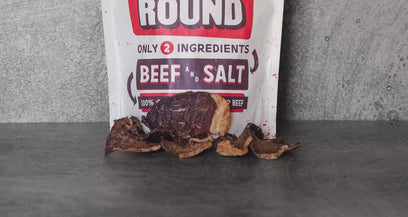THE CARNIVORE DIET BENEFITS




In a world increasingly aware of its environmental impact and dedicated to preserving our planet's resources, the search for sustainable farming practices is more than a mere trend. It's a necessity.
Regenerative agriculture stands at the forefront of this quest, promising not just sustainability but restoration of our ecosystems. One of the key benefits of regenerative agriculture is the remarkable improvements it brings to soil health, the bedrock upon which all farming relies.
Yet, how does this approach make such a difference, and what does that mean for us and our planet? As we delve into this guide on regenerative agriculture soil health, prepare to unearth the secrets of soil regeneration.
You'll learn how this farming methodology enriches the earth beneath our feet, nurturing biodiversity and bolstering resilience. You'll also discover how you, too, can play a part in supporting this movement.
Whether you're an agriculturist looking for sustainable farming methods, an environmental enthusiast keen on understanding better practices, or a consumer curious about the origins of your food, this article is your shovel to dig deeper. So, let's start tilling (or, perhaps not?).
Is There a Link Between Regenerative Agriculture & Soil Health?
Before we start dissecting the regenerative agriculture soil health link, let’s set the stage a bit. So, for those who are new here, what is regenerative agriculture? How does regenerative agriculture work, and why is regenerative agriculture important?
A Brief Overview of Regenerative Farming
Simply put, regenerative agriculture is a sustainable approach to growing or raising food. There are a multitude of regenerative farming techniques used, including cover cropping, crop rotation, rotational grazing, and minimal tillage.
And, instead of harmful synthetic inputs like pesticides or fertilizers, farmers rely on inputs from the land itself - like beneficial bugs or regenerative farming fertilizer.
The goal? To cultivate soils rich in organic matter and teeming with microbial life. The result is a vibrant soil ecosystem that supports robust plant growth, biodiversity, and, importantly, healthier and more nutrient-dense food.
The Importance of Healthy Soil
Why does soil health matter so much, though? Picture soil as a vast, bustling city where countless tiny organisms - the microbes - live and work. They break down organic matter, releasing essential nutrients that plants absorb.
These nutrients, in turn, influence the nutritional content of the food we eat. It's a natural, beautiful cycle where every participant contributes to and benefits from the overall health of the system.
Does Regenerative Agriculture Actually Improve Soil Health?
So, is there actually a link between regenerative agriculture soil health? An intriguing study recently published in the journal PeerJ put this theory to the test.
Researchers examined a network of regenerative farms across various locations in the United States and compared the nutritional content of their crops to those grown on neighboring conventional farms.
The crops studied were the same, grown in similar climate conditions, and even the soil type was the same. The difference was the farming practices; the regenerative farms had been employing soil-building techniques for at least five years.
The findings? Food grown on regenerative farms contained significantly more essential minerals like magnesium, calcium, potassium, and zinc. They had more vitamins and phytochemicals, the compounds that provide antioxidant and anti-inflammatory benefits. Moreover, these foods had lower levels of elements detrimental to human health, like sodium, cadmium, and nickel. In short, the study pointed to a clear link between soil health and the nutrient-density of food.
The study goes a step further, noting that soil health influences phytochemical levels in crops. These compounds reduce the risk of various chronic diseases, leading researchers to conclude that regenerative farming systems could potentially enhance dietary levels of these beneficial compounds.
Now, picture what could happen if we adopted these regenerative practices on a wider scale. Not only could we rejuvenate our soils, but we could also improve the nutritional quality of our food, supporting better human health. All this while also promoting biodiversity and building resilience against climate variability.
Regenerative agriculture's approach to soil health could be a significant step toward combating chronic diseases and ensuring food security. It's an exciting possibility and one that shows the profound impact our farming choices can have on soil health and, by extension, our own health.
That being said, let’s progress the conversation a bit by looking at the mechanisms behind these regenerative agriculture soil health improvements.
How Does Regenerative Agriculture Improve Soil Health?
In understanding how regenerative agriculture improves soil health, it's essential to dig into the nitty-gritty of its farming practices. There are a few key areas where regenerative agriculture directly impacts soil health. Let's get our hands dirty and unearth these mechanisms.
Organic Matter and Nutrient Recycling
At the heart of regenerative agriculture is the enrichment of soil organic matter (SOM). This matter is the lifeblood of the soil, a complex mixture of decomposing plant and animal material, microorganisms, and soil fauna.
SOM serves as a reservoir of nutrients that can be slowly released to plants, playing a critical role in the soil's fertility. Regenerative practices such as cover cropping and crop rotation help to diversify and increase the amount of organic matter entering the soil.
Cover crops are grown not for harvest but to protect and enrich the soil, reducing erosion, increasing SOM, and enhancing nutrient cycling.
On the other hand, crop rotation disrupts pest and disease cycles while also providing a variety of organic materials to the soil, boosting its fertility over time.
Biological Activity: Role of Microbes and Earthworms
The soil is an incredibly diverse and dynamic habitat teeming with life. Microorganisms (like bacteria and fungi) and larger organisms (like earthworms) play vital roles in maintaining soil health.
In regenerative agriculture, practices like minimal tillage and organic amendments encourage a thriving soil biome. Healthy soil microbiomes are responsible for decomposing organic material, which recycles nutrients back into the soil. This activity results in the creation of humus, a stable form of organic matter that improves soil structure and holds onto nutrients.
Earthworms, often dubbed as 'nature's plow', contribute to soil health by creating channels that improve soil aeration and water infiltration. Their digestion of organic material also produces nutrient-rich castings, a natural soil conditioner.
Soil Structure: Encouraging Aggregation and Porosity
Regenerative practices also enhance the physical structure of the soil. A healthy soil has good aggregation - clumps of soil particles bound together. These aggregates create spaces (pores) in the soil that allow roots to penetrate deeply and water to infiltrate efficiently.
Cover cropping and reduced tillage, both pillars of regenerative agriculture, promote this aggregation. The plant roots and soil microbes exude sticky substances that help to bind soil particles together into aggregates. By keeping the soil covered and minimally disturbed, the aggregates are preserved, leading to improved soil structure over time.
Water Retention: A Key to Resilience
The capacity of soil to retain water is another key factor in its health and resilience, especially in the face of changing climate conditions. Healthy soils with high organic matter content and good structure can hold more water, providing a buffer during dry periods.
Through increasing SOM and improving soil structure, regenerative agriculture enhances the soil's water-holding capacity. This benefit not only supports plant growth during dry spells but also helps mitigate flooding during heavy rainfalls by increasing water infiltration rates. You can learn more about this in our conversation on water benefits of regenerative agriculture.
In the grand picture, each of these elements contributes to a resilient, vibrant soil ecosystem that can nourish crops, support biodiversity, and even capture carbon from the atmosphere.
By choosing products from farms that follow these regenerative practices, you're playing a part in fostering this healthy soil community, reinforcing the connection between the health of our soils and our own wellbeing.
We’ll talk more about how to support regenerative agriculture shortly. But, regenerative agriculture soil health improvements is really just the tip of the iceberg. So, let’s look at a few of the other profound implications of this approach to farming.
More Benefits Beyond Regenerative Agriculture Soil Health Improvements
While the substantial soil health improvements are a considerable benefit, the practice of regenerative agriculture goes beyond the ground under our feet. There is a range of additional benefits of regenerative farming that touch upon farmer livelihoods, biodiversity, food security and quality, and more.
Better Outcomes For Farmers
A healthy, fertile soil can significantly impact a farm's bottom line. Improvements in soil health often lead to greater crop yields and, in turn, enhanced economic stability for farmers. But the advantages of regenerative farming are not just monetary.
Farmers who adopt regenerative practices often report a newfound connection to their land. They note the satisfaction that comes from seeing their soils, crops, and farm ecosystems improve year after year.
Moreover, regenerative farming methods can decrease dependence on expensive synthetic fertilizers and pesticides, making farming a more sustainable livelihood in the long run. Learn more about the profitability of regenerative farming in our complete guide.
Building Resilience & Biodiversity
Regenerative agriculture helps build resilience at both the field and landscape levels. Healthy soils can weather the storm - quite literally - being better equipped to handle extreme weather events like droughts and heavy rainfalls. This resilience extends to coping with pest outbreaks and disease, thanks to the increase in biological diversity in and above the soil.
By fostering a variety of life, from microorganisms to insects, birds, and mammals, regenerative agriculture helps maintain robust ecosystems. These ecosystems support essential services, such as pollination, pest control, and disease regulation, that conventional farming often neglects. Learn more about regenerative agriculture biodiversity in our blog.
Contributing to Superior Food Security and Quality
Regenerative agriculture can also enhance food security and quality. Diverse, resilient farming systems are more likely to provide stable yields over time, even under adverse conditions. This reliability is essential in ensuring a consistent food supply.
Beyond security, the quality of the food produced can also see a significant upgrade. As we've previously discussed, soil health is closely linked with nutrient content in crops. Therefore, healthier soils typically lead to more nutrient-dense harvests, providing healthier, tastier food for consumers.
The Role in Carbon Sequestration
Perhaps one of the most critical benefits of regenerative agriculture in our era of climate concern is its potential to sequester carbon. Healthy soils rich in organic matter act as carbon sinks, absorbing and storing carbon dioxide from the atmosphere.
Through practices like cover cropping, reduced tillage, and rotational grazing, regenerative agriculture not only reduces emissions from farming activities but can also draw down existing atmospheric carbon. This carbon is stored in the soil and used to fuel plant growth and microbial activity, effectively turning farms into part of the climate solution.
We have a complete guide on how regenerative agriculture sequesters carbon if you want to learn more. But at this point, we want to talk about what you can do - whether you’re a farmer or a consumer - to help progress our world towards this more sustainable approach to food supply.
How to Get Started or Show Your Support Today
So, you're fired up about regenerative agriculture and its potential for transformative change - from revitalizing our soils to enhancing biodiversity, ensuring food security, and even restoring our land. But how can you make a difference?
For those fortunate enough to own or manage agricultural land, the first step could be to adopt regenerative practices. There's an increasing number of resources, from online courses to field days and farmer networks, that can help guide your transition. We even have our own resource on how to do regenerative farming!
However, the vast majority of us are not farmers, but we still play an essential role. We can choose to support regenerative agriculture through our food choices. Look for products that are sourced from regenerative farms. Transparency in sourcing is essential, so don't be afraid to ask questions of your food providers or do a little digging yourself.
Consider brands that prioritize and invest in regenerative agriculture. For instance, when you choose our meat chips, you're not just selecting a delicious, nutrient-packed treat, but you're also supporting farmers who are building healthier soils and robust ecosystems. It's a small act that contributes to a larger movement.
Finally, share your knowledge. The more people understand the importance of soil health and the benefits of regenerative agriculture, the more demand there will be for regeneratively grown foods. Use your voice to spread the word about the power of regenerative agriculture. And, with that said, it’s time we wrapped up our conversation on regenerative agriculture soil health.
Bringing Our Conversation on Regenerative Agriculture Soil Health to a Close
Regenerative agriculture holds the promise of transforming the health of our soils and our food system. Its focus on soil health ensures the well-being of our environment and contributes to producing more nutrient-dense food.
This shift in agriculture is not just about farmers changing their practices, but also about us, the consumers, changing our choices and advocating for better farming methods.
By understanding the interplay of regenerative agriculture soil health, we can make informed decisions that support not only our health but also the well-being of our planet.
We hope that you will join us in supporting this crucial shift towards regenerative practices, be it through purchasing our Carnivore Chips or through your voice. After all, the health of our soils affects the health of our food, and in turn, our own health. Isn’t that worth fighting for?























